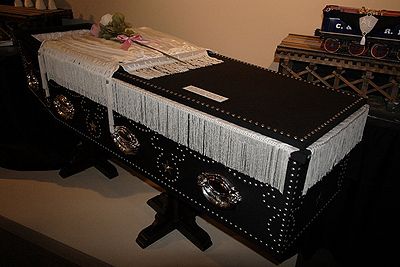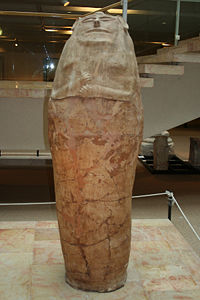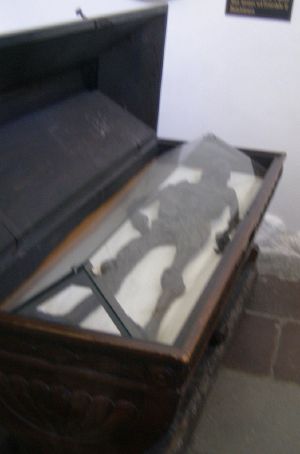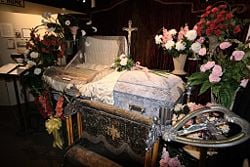Difference between revisions of "Coffin" - New World Encyclopedia
(started) |
|||
| Line 3: | Line 3: | ||
[[Category:Anthropology]] | [[Category:Anthropology]] | ||
| − | [[Image: | + | [[Image:Chu State Lacquer Coffin.JPG|thumb|right|200px|A Chinese [[lacquer]] coffin decorated with birds and dragons, from the [[State of Chu]], 4th century B.C.E.]] |
| + | A '''coffin''', or '''casket''', is a funerary [[box]] used in the display and containment of deceased remains for [[burial]] or for [[cremation]]. Any box used to bury the dead in can serve as a coffin; such containers are generally used to protect and aid in the preservation of a body. The word is derived from the [[Ancient Greek|Greek]] word ''kophinos'' meaning “basket”. In [[English language|English]], the word wasn't used in a [[funeral]] sense until the 1500s. Use of the word "casket" began as a [[euphemism]] introduced by the [[undertaker]]'s trade in North America; a "casket" was originally a box for jewelry. <ref>[http://www.bartleby.com/68/43/1143.html casket, coffin (nn.)] from the ''[[Columbia Guide to Standard American English]]'' via [[Bartleby.com]]</ref> | ||
| + | Many professionals draw a distinction between "coffins" and "caskets". A coffin is often a tapered [[hexagon]]al or [[octagonal]] box used for a burial. A [[rectangular]] burial box with a split lid used for viewing the deceased is often termed a "casket". When a coffin or casket is used to transport a [[deceased]] person, it can also be called a [[pall]], a term that also refers to the cloth used to cover the coffin and to those carrying the casket, known as “pallbearers”. Receptacles for [[cremated]] human ashes, sometimes called “cremains”, are called [[urns]]. | ||
| − | + | The handles and other ornaments, such as doves, stipple crosses, crucifixes, or masonic symbols that often adorn the outside of a coffin are called “fittings” or “coffin furniture”. Organization of the inside of the coffin with various draperies is known as "trimming". | |
| − | |||
| − | + | ==History== | |
| + | [[Image:Anthropoid coffin.jpg|right|thumb|200px|[[Anthropoid]] coffin, 14th-13th centuries B.C.E.]] | ||
| + | Various past religions believed coffins to confine the spirit of the dead, and often employed caskets in burial to prevent the spirit of the deceased from visiting the world of the living after death. In early primitive societies, bark, animal skins, or basic mats were used to wrap the body before burial practices. Societies living close to large rivers or shores often buried their dead in canoes or other floating containers. People of the [[Bronze Age]] are believed to have used hollow oak coffins to bury their dead, while the early [[Greeks]] and [[Chaldaens]] often sealed their dead in clay containers by firing it. [[Ancient Egyptian]] practices used large stone coffins, known as [[sarcophaguses]] to contain the bodies of the dead, namely citizens of great social stature. Egyptians also used materials of wood and [[papier-mâché]] to craft [[mummy]] chests. Coffins lined with more resilient materials such as metal or lead date back to the [[Middle Ages]]. In the 18th and 19th centures, many [[Taiwanese]] coffins were constructed of crushed oyster shells. Today, most coffins of the Western World are crafted out of wood and may be adorned or lined with elements of bronze, copper, lead or zinc <ref> The Columbia Electronic Encyclopedia, Sixth Edition </ref>. | ||
| − | |||
| − | |||
| − | |||
==Practices== | ==Practices== | ||
| − | |||
| − | |||
| − | |||
| − | |||
| − | |||
| − | |||
| − | |||
| − | |||
[[Image:Haraldskaerwoman.jpg|right|thumb|The glass-covered coffin of the [[Haraldskær Woman]].]] | [[Image:Haraldskaerwoman.jpg|right|thumb|The glass-covered coffin of the [[Haraldskær Woman]].]] | ||
| − | + | A coffin may be buried directly in the ground, placed in a [[burial vault]] or cremated. Above ground burials are housed in a [[mausoleum]], often a large cement building on the grounds of a cemetery, or a small personal crypt. Coffins can be made of many materials, including steel, various types of wood, and other materials such as fiberglass. Recent manufacturing has lead to the invention of eco-friendly coffins made entirely of natural materials such as bamboo <ref>[http://news.bbc.co.uk/2/hi/business/1730190.stm Bamboo Coffins "Coffin-maker resurrects tradition"], from BBC Business News, published 2001-12-28</ref>. | |
| − | + | Cultures that practice burial often have widely different styles of coffins. In some varieties of [[orthodox Judaism]], the coffin must be plain, made of wood, and contain no metal parts nor adornments. These coffins also use wooden pegs in place of nails. In [[China]] and [[Japan]], coffins made from the scented, decay-resistant wood of [[Cupressaceae|cypress]], [[sugi]], [[thuja]] and [[incense-cedar]] are often used. According to various [[African]] traditions, elaborate coffins may be built in the shapes of mundane objects, such as automobiles or airplanes. | |
| − | + | Sometimes coffins are constructed to display the dead body, as in the case of the glass-covered coffin of the [[Haraldskær Woman]], on display in the [[Church of Saint Nicolai]] in [[Vejle]], [[Denmark]]. | |
| − | == | + | ===Cremation Coffins=== |
| − | + | With the resurgence of cremation in the [[Western world]], many coffin manufacturers have begun providing options for those who choose [[cremation]]. For a direct cremation, a typical urn or similar container is normally used. Those who wish to have a [[viewing]] or traditional funeral service may use a cremation coffin. Family members may choose to use a coffin made of wood or other materials like particle board. Others may rent a regular casket for the duration of the services. These caskets have a removable bed and liner which is replaced after each use. There are also rental caskets with an outer shell made to look like a traditional coffin and a cardboard box that fits inside the shell to house the cremated remains. | |
| − | + | ==Coffin Industry== | |
| + | [[Image:Viewing (museum display).JPG|thumb|250 px|Viewing Casket, The Museum of Funeral Customs.]] | ||
| + | In the United States, a number of companies produce caskets. Some manufacturers refrain from selling directly to the public, and work only with licensed funeral homes. In such cases, the funeral home may sell the casket to the family of a deceased person as part of the services offered. | ||
| − | + | Often funeral homes may have a small showroom to present families with the available caskets that could be purchased for a deceased family member. In many modern funeral homes the showroom will consist of sample pieces that show the end pieces of each type of coffin that can be used. They may also include samples of the lining and other materials that can be chosen to adorn the coffin. This allows funeral homes to showcase a larger number of coffin styles without the need for a larger showroom. Examples of such showrooms can be seen on the [[A&E Network|A&E]] show ''[[Family Plots]]'', and the [[HBO]] drama ''[[Six Feet Under]].'' | |
| − | + | One manufacturer of caskets is the [[New Melleray Abbey]] of rural [[Peosta, Iowa]]. The monks of this abbey build wooden caskets and urns for their own use, as well as for sale to the general public. The caskets are popularly known as [[Trappist Caskets]]. | |
| − | + | Under U.S. federal law, if a family provides a casket they purchased elsewhere, the establishment is required to accept the casket and use it in the services. If the casket is delivered direct to the funeral home from the manufacturer or store, they are required to accept delivery of the casket. The funeral home may not add any extra charges or fees to the overall bill if a family decides to purchase a casket elsewhere. | |
| − | + | ==Contemporary Coffins== | |
| − | + | [[Image:Lincoln's coffin, replica.JPG|right|thumb|400px|A replica of the coffin used for [[Abraham Lincoln]], on display at the [[Museum of Funeral Customs]].]] | |
| − | == | ||
| − | [[Image: | ||
| − | |||
| − | + | Today, manufacturers of coffins often include features to protect the body. For example, some manufacturers may offer a ''protective casket'' that uses a [[gasket]] to seal the casket shut after the coffin is finally closed. Manufacturers may also offer a warranty on the structural integrity of the coffin. However, no coffin can adequately preserve the body, regardless of whether it is a wooden or metal coffin, a sealed casket, or if the deceased was [[embalmed]] beforehand. In some cases, a sealed coffin may actually accelerate the process of decomposition. An airtight coffin, for example, may foster decomposition by [[anaerobic bacteria]], which results in a [[putrefaction| putrefied]] [[liquification]] of the body; all putrefied tissue would remain inside the container, only to be exposed in the event of an exhumation. A container that allows air molecules to pass in and out, such as a simple wooden box, allows for aerobic decomposition that results in much less noxious odor and clean [[skeleton]]ization. | |
| − | + | ==Unusual Coffins== | |
| − | |||
| − | |||
| − | |||
| − | == Unusual | ||
[[Image:Kasket.jpg||thumb|right|Kiss Coffin]] | [[Image:Kasket.jpg||thumb|right|Kiss Coffin]] | ||
| − | |||
| − | |||
| − | |||
| − | |||
| − | |||
| + | Custom coffins are occasionally created; some companies also make set ranges with non-traditional designs. These may include paintings of peaceful tropical scenes, sea-shells, sunsets and cherubs. Some coffins have been designed to look like gym carry bags, guitar cases and even yellow dumpster bins. Coffins may also be personalized to offer college insignia or different head panels to better reflect the deceased's life choices. Others coffins are left deliberately blank so that friends and family can inscribe final wishes and thoughts upon it to the deceased. The [[Hard Rock|rock]] band [[Kiss (band)|Kiss]] has made a coffin called the [[Kiss Kasket]] for their most diehard fans; [[Dimebag Darrell]], guitarist of both [[Pantera]] and [[Damageplan]], was buried in one such casket. | ||
==Notes== | ==Notes== | ||
| − | |||
<references/> | <references/> | ||
==References== | ==References== | ||
| + | *The Columbia Electronic Encyclopedia, Sixth Edition. [[http://www.answers.com/topic/coffin Coffin]]. Columbia University Press., 2003. Retrieved 08 Sep. 2007. | ||
| + | |||
| + | *The Oxford Essential Dictionary of the U.S. Military. [[http://www.answers.com/topic/coffin Coffin]]. Oxford University Press, 2001, 2002. Retrieved 08 Sep. 2007. | ||
| + | |||
| + | *The Concise Oxford Dictionary of Archaeology. [[Archaeology Dictionary Coffin]]. Copyright © 2002, 2003. Oxford University Press. Retrieved 09 Sep. 2007. | ||
| + | ==External Links== | ||
| + | *[http://www.funeralsearch.co.uk/cardboard-coffins.php Cardboard Coffins] | ||
| + | *[http://www.oxfordcoffins.com/faqs.html Colourful Coffins] | ||
| + | *[http://www.funeralmuseum.org/index-2.html The Museum of Funeral Customs] | ||
{{Credits|Coffin|154833917|}} | {{Credits|Coffin|154833917|}} | ||
Revision as of 18:24, 9 September 2007
A coffin, or casket, is a funerary box used in the display and containment of deceased remains for burial or for cremation. Any box used to bury the dead in can serve as a coffin; such containers are generally used to protect and aid in the preservation of a body. The word is derived from the Greek word kophinos meaning “basket”. In English, the word wasn't used in a funeral sense until the 1500s. Use of the word "casket" began as a euphemism introduced by the undertaker's trade in North America; a "casket" was originally a box for jewelry. [1]
Many professionals draw a distinction between "coffins" and "caskets". A coffin is often a tapered hexagonal or octagonal box used for a burial. A rectangular burial box with a split lid used for viewing the deceased is often termed a "casket". When a coffin or casket is used to transport a deceased person, it can also be called a pall, a term that also refers to the cloth used to cover the coffin and to those carrying the casket, known as “pallbearers”. Receptacles for cremated human ashes, sometimes called “cremains”, are called urns.
The handles and other ornaments, such as doves, stipple crosses, crucifixes, or masonic symbols that often adorn the outside of a coffin are called “fittings” or “coffin furniture”. Organization of the inside of the coffin with various draperies is known as "trimming".
History
Various past religions believed coffins to confine the spirit of the dead, and often employed caskets in burial to prevent the spirit of the deceased from visiting the world of the living after death. In early primitive societies, bark, animal skins, or basic mats were used to wrap the body before burial practices. Societies living close to large rivers or shores often buried their dead in canoes or other floating containers. People of the Bronze Age are believed to have used hollow oak coffins to bury their dead, while the early Greeks and Chaldaens often sealed their dead in clay containers by firing it. Ancient Egyptian practices used large stone coffins, known as sarcophaguses to contain the bodies of the dead, namely citizens of great social stature. Egyptians also used materials of wood and papier-mâché to craft mummy chests. Coffins lined with more resilient materials such as metal or lead date back to the Middle Ages. In the 18th and 19th centures, many Taiwanese coffins were constructed of crushed oyster shells. Today, most coffins of the Western World are crafted out of wood and may be adorned or lined with elements of bronze, copper, lead or zinc [2].
Practices
A coffin may be buried directly in the ground, placed in a burial vault or cremated. Above ground burials are housed in a mausoleum, often a large cement building on the grounds of a cemetery, or a small personal crypt. Coffins can be made of many materials, including steel, various types of wood, and other materials such as fiberglass. Recent manufacturing has lead to the invention of eco-friendly coffins made entirely of natural materials such as bamboo [3].
Cultures that practice burial often have widely different styles of coffins. In some varieties of orthodox Judaism, the coffin must be plain, made of wood, and contain no metal parts nor adornments. These coffins also use wooden pegs in place of nails. In China and Japan, coffins made from the scented, decay-resistant wood of cypress, sugi, thuja and incense-cedar are often used. According to various African traditions, elaborate coffins may be built in the shapes of mundane objects, such as automobiles or airplanes.
Sometimes coffins are constructed to display the dead body, as in the case of the glass-covered coffin of the Haraldskær Woman, on display in the Church of Saint Nicolai in Vejle, Denmark.
Cremation Coffins
With the resurgence of cremation in the Western world, many coffin manufacturers have begun providing options for those who choose cremation. For a direct cremation, a typical urn or similar container is normally used. Those who wish to have a viewing or traditional funeral service may use a cremation coffin. Family members may choose to use a coffin made of wood or other materials like particle board. Others may rent a regular casket for the duration of the services. These caskets have a removable bed and liner which is replaced after each use. There are also rental caskets with an outer shell made to look like a traditional coffin and a cardboard box that fits inside the shell to house the cremated remains.
Coffin Industry
In the United States, a number of companies produce caskets. Some manufacturers refrain from selling directly to the public, and work only with licensed funeral homes. In such cases, the funeral home may sell the casket to the family of a deceased person as part of the services offered.
Often funeral homes may have a small showroom to present families with the available caskets that could be purchased for a deceased family member. In many modern funeral homes the showroom will consist of sample pieces that show the end pieces of each type of coffin that can be used. They may also include samples of the lining and other materials that can be chosen to adorn the coffin. This allows funeral homes to showcase a larger number of coffin styles without the need for a larger showroom. Examples of such showrooms can be seen on the A&E show Family Plots, and the HBO drama Six Feet Under.
One manufacturer of caskets is the New Melleray Abbey of rural Peosta, Iowa. The monks of this abbey build wooden caskets and urns for their own use, as well as for sale to the general public. The caskets are popularly known as Trappist Caskets. Under U.S. federal law, if a family provides a casket they purchased elsewhere, the establishment is required to accept the casket and use it in the services. If the casket is delivered direct to the funeral home from the manufacturer or store, they are required to accept delivery of the casket. The funeral home may not add any extra charges or fees to the overall bill if a family decides to purchase a casket elsewhere.
Contemporary Coffins

Today, manufacturers of coffins often include features to protect the body. For example, some manufacturers may offer a protective casket that uses a gasket to seal the casket shut after the coffin is finally closed. Manufacturers may also offer a warranty on the structural integrity of the coffin. However, no coffin can adequately preserve the body, regardless of whether it is a wooden or metal coffin, a sealed casket, or if the deceased was embalmed beforehand. In some cases, a sealed coffin may actually accelerate the process of decomposition. An airtight coffin, for example, may foster decomposition by anaerobic bacteria, which results in a putrefied liquification of the body; all putrefied tissue would remain inside the container, only to be exposed in the event of an exhumation. A container that allows air molecules to pass in and out, such as a simple wooden box, allows for aerobic decomposition that results in much less noxious odor and clean skeletonization.
Unusual Coffins
Custom coffins are occasionally created; some companies also make set ranges with non-traditional designs. These may include paintings of peaceful tropical scenes, sea-shells, sunsets and cherubs. Some coffins have been designed to look like gym carry bags, guitar cases and even yellow dumpster bins. Coffins may also be personalized to offer college insignia or different head panels to better reflect the deceased's life choices. Others coffins are left deliberately blank so that friends and family can inscribe final wishes and thoughts upon it to the deceased. The rock band Kiss has made a coffin called the Kiss Kasket for their most diehard fans; Dimebag Darrell, guitarist of both Pantera and Damageplan, was buried in one such casket.
Notes
- ↑ casket, coffin (nn.) from the Columbia Guide to Standard American English via Bartleby.com
- ↑ The Columbia Electronic Encyclopedia, Sixth Edition
- ↑ Bamboo Coffins "Coffin-maker resurrects tradition", from BBC Business News, published 2001-12-28
ReferencesISBN links support NWE through referral fees
- The Columbia Electronic Encyclopedia, Sixth Edition. [Coffin]. Columbia University Press., 2003. Retrieved 08 Sep. 2007.
- The Oxford Essential Dictionary of the U.S. Military. [Coffin]. Oxford University Press, 2001, 2002. Retrieved 08 Sep. 2007.
- The Concise Oxford Dictionary of Archaeology. Archaeology Dictionary Coffin. Copyright © 2002, 2003. Oxford University Press. Retrieved 09 Sep. 2007.
External Links
Credits
New World Encyclopedia writers and editors rewrote and completed the Wikipedia article in accordance with New World Encyclopedia standards. This article abides by terms of the Creative Commons CC-by-sa 3.0 License (CC-by-sa), which may be used and disseminated with proper attribution. Credit is due under the terms of this license that can reference both the New World Encyclopedia contributors and the selfless volunteer contributors of the Wikimedia Foundation. To cite this article click here for a list of acceptable citing formats.The history of earlier contributions by wikipedians is accessible to researchers here:
The history of this article since it was imported to New World Encyclopedia:
Note: Some restrictions may apply to use of individual images which are separately licensed.


